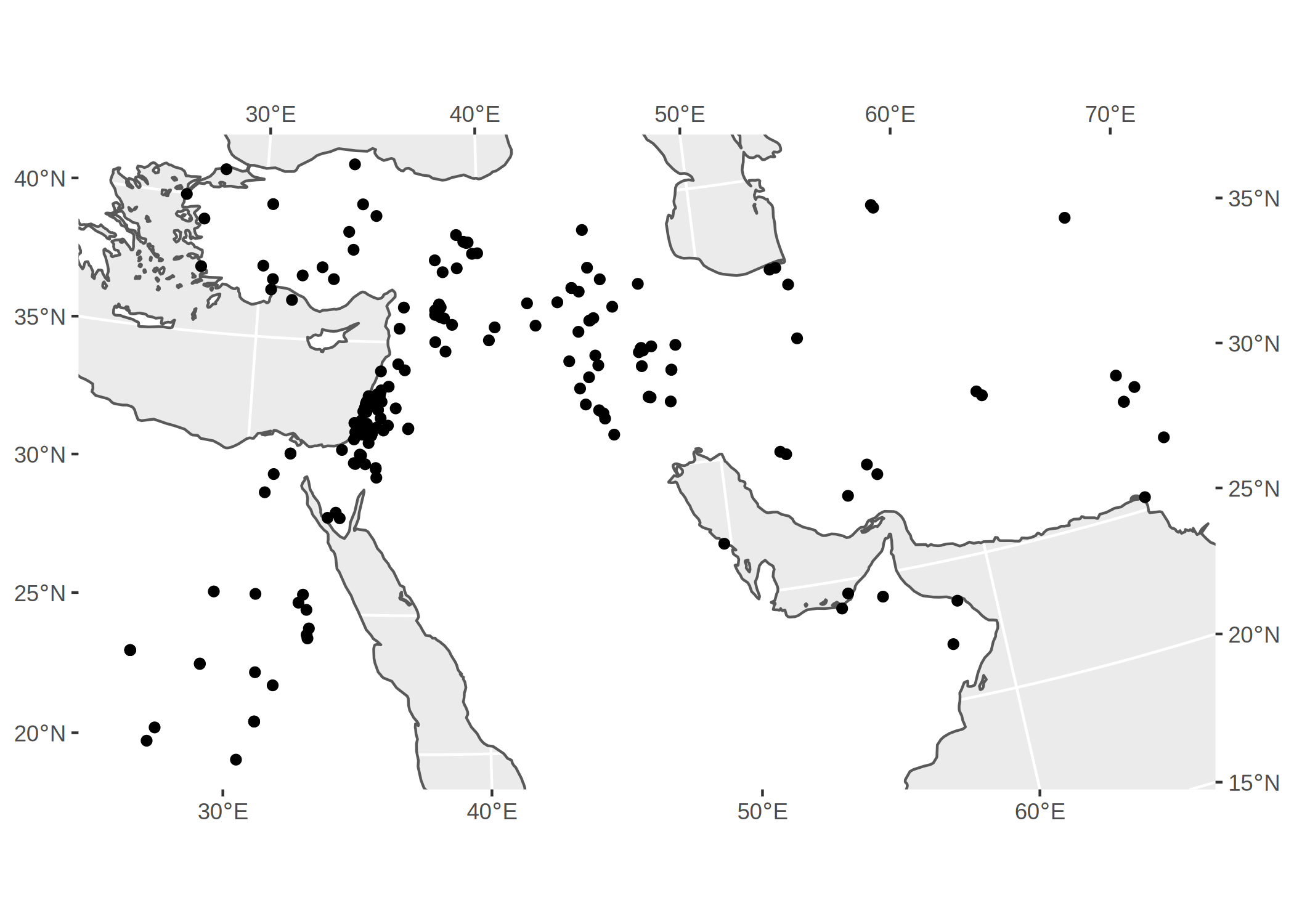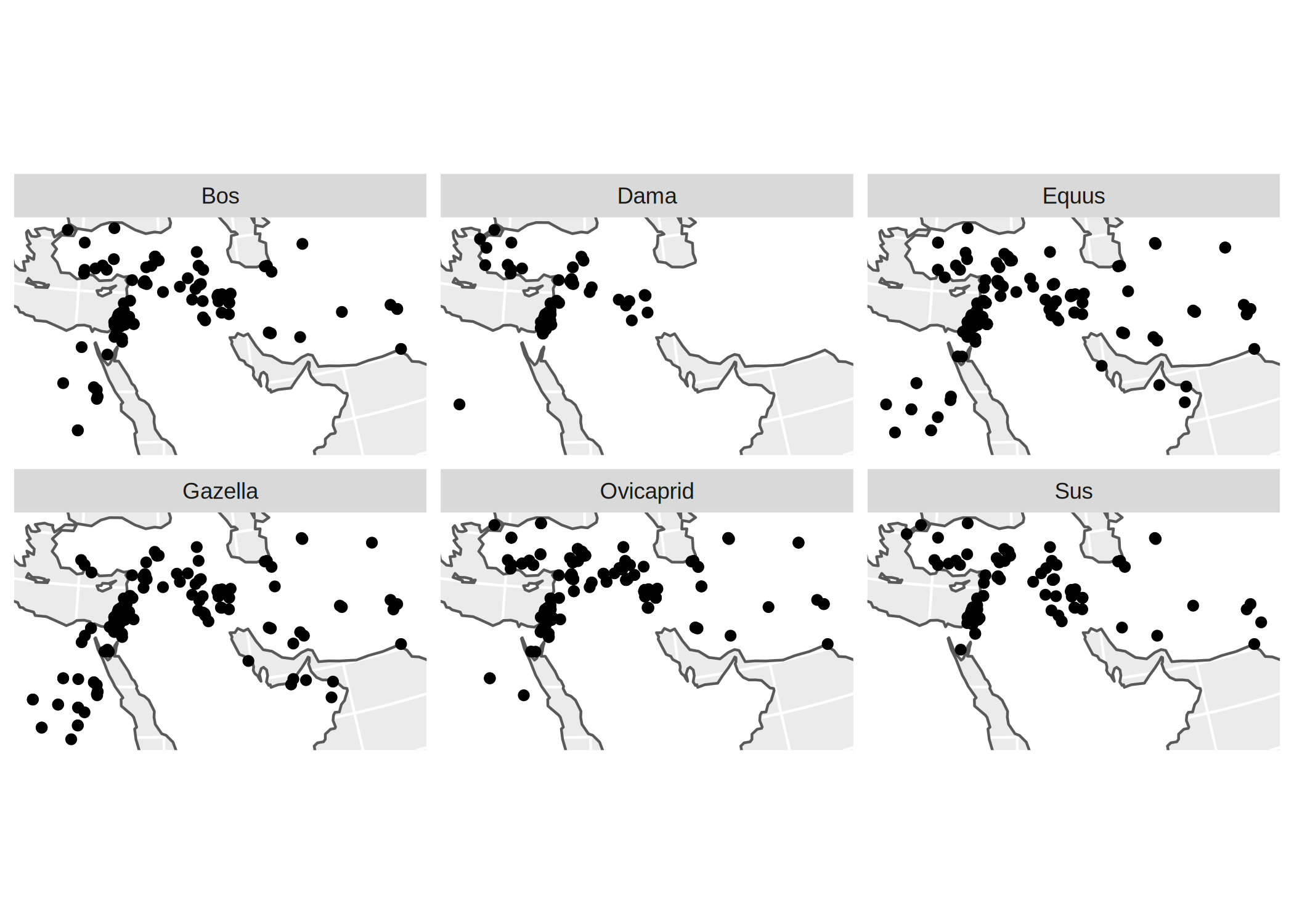This repository contains data from Uerpmann’s (1987), The Ancient Distribution of Ungulate Mammals in the Middle East, volume 27 of the Tübinger Atlas des Vorderen Orients (TAVO), Series A.
Uerpmann catalogued the occurrence of ungulate taxa in animal bone assemblages from 196 sites across the Middle East, from the Lower Palaeolithic to the historic period. Though no longer up-to-date, it remains one of the most comprehensive resources on quaternary biogeography in Southwest Asia. Here, the catalogue included in the volume has been transcribed into a structured format suitable for modern computerised data analysis.
The data is provided in a
tidy, tabular format in
tavo-a27.tsv (tab-seperated) and
tavo-a27.csv (comma-seperated). Column headings are
given in the first row. The occurrence data is coded as a series of
boolean columns, where 1 indicates the presence of a taxon at a site
and 0 its absence.
Below is a simple example of how to import and visualise the data in R.
library("tidyverse")
library("sf")
library("rnaturalearth")
tavo <- read_tsv("tavo-a27.tsv", col_types = cols())
# Reshape data into a table of occurrences
tavo %>%
gather("taxon", "occurrence", 9:79) %>%
filter(occurrence == 1) ->
tavo
# Recode and filter to selected taxa of interest
tavo %>%
mutate(taxon = case_when(
grepl("Gazella*", taxon) ~ "Gazella",
grepl("Equus*", taxon) ~ "Equus",
grepl("Dama*", taxon) ~ "Dama",
grepl("Ovis*", taxon) ~ "Ovicaprid",
grepl("Capra*", taxon) ~ "Ovicaprid",
grepl("Bos*", taxon) ~ "Bos",
grepl("Sus*", taxon) ~ "Sus",
)) %>%
filter(taxon %in% c("Gazella", "Equus", "Dama", "Ovicaprid", "Bos", "Sus")) ->
tavo
# Convert to simple features spatial object
tavo %>%
drop_na(latitude, longitude) %>%
st_as_sf(crs = 4326, coords = c("longitude", "latitude"), remove = FALSE,
agr = "constant") %>%
st_transform(crs = 22770) -> # EPSG:22770 / Syria Lambert
tavo
# Plot
box <- st_bbox(tavo)
land <- ne_download(110, "land", "physical", returnclass = "sf") %>%
st_crop(xmin = 0, xmax = 90, ymin = 0, ymax = 60) %>%
st_transform(crs = 22770)
ggplot(tavo) +
facet_wrap(vars(taxon)) +
geom_sf(data = land, fill = "white") +
geom_sf() +
coord_sf(xlim = c(box$xmin, box$xmax), ylim = c(box$ymin, box$ymax),
label_axes = "----")Generally, the data has been transcribed from the published volume with mimimal changes. No attempt has been made to update or standardise the site names, dating, taxonomy, etc., to reflect subsequent research.
- The
idcolumn corresponds to the numbers assigned to the sites by Uerpmann and used in the maps in the volume. - Several sites have duplicate ID numbers (Korucutepe, Körtepe, Rakefet, Tepecik, Tülintepe). These were reassigned the next IDs in the sequence (197–201).
- Uerpmann’s descriptions of the chronology of sites are standardised
to a list of periods seperated by a semicolon
;. - The acronyms and abbreviations are those used by Uerpmann, viz.:
- histor: historic
- Isl: Islamic
- Byz: Byzantine
- Rom: Roman
- Hell: Hellenistic
- IA: Iron Age
- BA: Bronze Age
- LN: Late Neolithic
- EN: Early Neolithic
- PN: Protoneolithic (i.e. the Natufian and contemporary cultures and PPNA)
- EP: Epipalaelithic
- UP: Upper Palaeolithic
- MP: Middle Palaeolithic
- LP: Lower Palaeolithic
- Time periods joined with a dash are expanded to a list of all the intervening periods (e.g. “EP–LN” becomes (“EP;PN;EN;LN”).
- “+ later” is ignored.
The locations of the sites are indicated on maps throughout Uerpmann’s
volume, but exact coordinates are not given in the text or catalogue.
The coordinates included in this dataset have therefore been compiled
from various other sources, with citations provided in the
coord_source column. See tavo-a27.bib for the full references in
BibTex format. They can be assumed to be accurate to within
approximately ±1 km.
- Uerpmann’s various notation for indeterminate species (e.g. “cf. Oryx”, “Capra spec.”, “Hippotraginae indet.”) are standardised to the form Genus sp.
- All the taxa listed are included; Uerpmann’s commentary on the certainty of identification (e.g. “(?)”, “cf.”) is ignored.
- Taxa not identified to at least the genus (e.g. “large Bovidae”) are omitted.
Full references are provided in BibTex format in tavo-a27.bib.
- Citations are given in the data following Uerpmann
- As noted by Uerpmann, he references “usually only the last (and/or key-) publication concerning the respective site”.
- References to other authors marked “ms.”, “unpub.”, etc. are standardised to “pers. comm.”
- References to (as then) unpublished work by Uerpmann are standardised to “Uerpmann 1987” (i.e., the TAVO A27 volume)
- Additional citations are included in the data for the source of coordinates.
Please cite Uerpmann’s original volume when using this data:
- Hans Peter Uerpmann. (1987). The Ancient Distribution of Ungulate Mammals in the Middle East. Tübinger Atlas des Vorderen Orients (TAVO), Reihe A (Naturwissenschaften), Nr. 27. Wiesbaden: Dr. Ludwig Reichert Verlag.
You can also cite this specific dataset via Zenodo:
- Joe Roe. (2019). Data from Uerpmann 1987, The Ancient Distribution of Ungulate Mammals in the Middle East, TAVO A27 (Version v1.0) [Data set]. Zenodo. http://doi.org/10.5281/zenodo.3362929
Further citations for specific assemblages are provided in the
fauna_source and coord_source columns. See tavo-a27.bib for the
full references in BibTex format.

